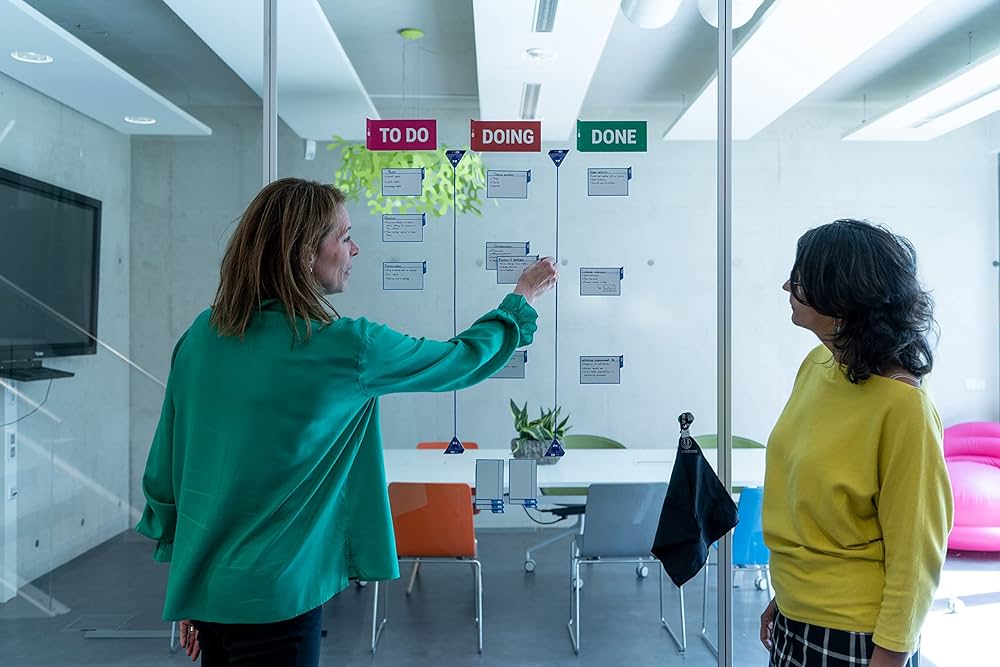
Managing Nearshore Software Development Teams can be a big challenge, especially when no working methodology is being followed. This is because the software development process requires complex, cross-functional collaboration while continuously improving products and services. Many software development companies are now opting to get their work done via Agile Teams which are flexible, super-fast, dependable, and most importantly efficient. Agile software development advocates for the use of small co-located teams to help reduce misunderstanding, aid face-to-face communication, and improve decision-making. According to the stats released by Atlassian in 2016, 88% of software development companies with 100 or fewer members use the Agile Software Development methodology.
Hire the best developers in Latin America. Get a free quote today!
Contact Us Today!In the early days of Agile working, the co-location principle was stubbornly adhered to and still remains the ‘gold standard’ of Agile development, but the business reality for many organizations today means co-location cannot be supported in many cases and for various reasons, including cutting costs, accessing specialized skills, and retaining talented developers, which has led to the use of outsourced developers, third party consultants, or geographically scattered team members. Interestingly, workers’ preference for remote work aligns with this trend. A staggering 98% of workers expressed the desire to work remotely, at least part of the time, and according to Statista, nearly 70% of the workforce in tech work remotely. Thanks to frameworks like Agile, nearshore software development teams working across borders can have equal chances of success. When you combine Agile and nearshore software development teams; you get Nearshore Agile Software Development Teams, which is possibly one of the greatest ease that the modern world can offer.
The shift to augmenting teams with nearshore developers makes it more important than ever for teams to cultivate an agile mindset. But how can you sustain performance in a remote environment?
In this article, you will get to know what Nearshore Agile Development is, its importance in the work environment, and how it can help companies navigate the unique challenges posed by remote work, such as the lack of face-to-face interaction, difficulty in collaboration, and lack of physical workspace. By the end of this article, you will have a better understanding of the Agile mindset and the strategies you can use to cultivate Agile values in a nearshore software development team.
What is the Agile Approach?
Agile is an approach to software development that seeks the continuous delivery of working software created in rapid iterations. Agile’s core values, principles, and practices are well-documented in the “Manifesto for Agile Software Development,” which was published in 2001 by 17 software developers — including Kent Beck, Martin Fowler, Jeff Sutherland, Ron Jeffries, and Ken Schwaber. The Agile Manifesto document was created as a response to the limitations of traditional, more rigid software development methodologies. The Agile approach later grew in importance as enterprise digitalization and software-driven processes became more prominent.
In practical terms, Agile development is a way of thinking about collaboration and workflows and it is a set of values that guide our choices in regards to what we make and how we make it. Agile software development methodologies are all about delivering small pieces of working software quickly to improve customer satisfaction. These methodologies use adaptive approaches and teamwork to focus on continuous improvement. Normally, Agile software development teams are inherently self-organizing and adaptive to change. The Agile methodology proposes that to stay effective, software developers, and business representatives should maintain a strong team culture of close collaboration, feedback loops and dynamic interaction by regularly meeting in person throughout the software development life cycle. If necessary, this allows the team to pivot quickly. When the Agile mindset is applied successfully, teams can produce higher-quality products in a shorter time.
The Agile approach can also be extended to areas such as Business Agility, for example, business executives may discuss how they might structure and operate their organizations in ways that allow them to respond to change when dealing with uncertainty. In any case, where Agility is deployed, the entire organization needs to support that mindset.
A crucial part of success with a nearshore software development team is clear, regular contact with everyone on the team. Agile supports this regular communication with tools such as Scrum. Agile also emphasizes using phone calls or video chats, which improves communication and can create more emotional rapport and respect.
Another facet of Agile communication is the idea of open communication and safety. There is even a person given the role of protecting open communication and solving barriers to expression, the Scrum Master. The more integrated the nearshore team is with their counterparts, the better everyone can communicate, solve problems, and create excellent products.
Agile Frameworks
Agile frameworks for software development—like Scrum, kanban, or extreme programming (XP)— form the basis for popular software development processes like DevOps and continuous integration/continuous deployment (CI/CD).
Scrum is perhaps the most popular agile framework in use today but not all agile is Scrum and, honestly, not all Scrum is agile. Scrum is a framework for managing work designed for small, cross-functional teams of 5 to 9 people who break their work into actions that can be completed within a consistent time frame called a sprint. Scrum teams consist of team members, a Scrum master, and a product owner. Typically, Scrum is implemented when a large project can be broken up into 2- to 4-week sprints. Scrum focuses on feedback loops through a ceremony called the “retrospective.” The unofficial motto of Scrum could be “inspect and adapt.”
Other agile frameworks, notably Kanban, predate the Agile Manifesto. However, these frameworks are considered to be agile because they promote the values outlined in the Agile Manifesto. There are too many agile frameworks and approaches to scaling agile to list all of them here.
The 12 Principles of Agile Software Development
The Agile Manifesto outlines the guiding principles of agile software development designed to prioritize flexibility, collaboration, and customer satisfaction. Here are the 12 principles that form the foundation of Agile Software Development:
- Customer satisfaction through early and continuous software delivery:
- This Agile principle underscores the importance of prioritizing customer satisfaction by providing value to the customer as early as possible in the project by consistently delivering working software at regular intervals (with a preference for shorter timescales) throughout the development process.
- Welcome changing requirements, even late in development:
- This second principle reflects the acknowledgment that customer needs and project requirements are likely to evolve over time. Instead of rigidly adhering to initial plans, Agile methodologies encourage teams to embrace and accommodate changes, even if they arise later in the development process.
- Deliver working software frequently, with a preference for shorter timescales:
- Aim to have a working, tested product at the end of every iteration or sprint.
- Collaboration between business people and developers throughout the project:
- It’s important to have continuous and close communication between those who understand the business aspects (such as product owners, stakeholders, or business analysts) and the software development team.
- Build projects around motivated individuals, give them the environment and support they need, and trust them to get the job done:
- Provide a supportive environment that allows motivated individuals to do their best work.
- The most efficient and effective method of conveying information to and within a development team is face-to-face conversation:
- This principle is rooted in the belief that face-to-face communication is considered the most effective means of conveying information within a team.
- Working software is the primary measure of progress:
- The ultimate goal is to deliver a working product, and progress is measured by the functionality of the software.
- Agile processes promote sustainable development. The sponsors, developers, and users should be able to maintain a constant pace indefinitely:
- It’s important to establish a work environment that allows all stakeholders, including sponsors, developers, and users, to maintain a consistent and manageable pace over the long term. Avoid overworking the team; maintain a sustainable pace to ensure long-term productivity and quality.
- Continuous attention to technical excellence and good design enhances agility:
- Emphasize the importance of quality and technical excellence in the development process.
- Simplicity—the art of maximizing the amount of work not done—is essential:
- Focus on what is necessary to meet the requirements; avoid unnecessary work.
- The best architectures, requirements, and designs emerge from self-organizing teams:
- This principle highlights the belief that when teams are trusted, empowered, and given the autonomy to self-organize, they are more likely to produce optimal architectures, requirements, and designs for the software they are developing. This approach aligns with the Agile philosophy of valuing individuals and fostering a collaborative and adaptive development environment.
- At regular intervals, the team reflects on how to become more effective, then tunes and adjusts its behavior accordingly:
- This principle encourages teams to regularly take time for introspection, self-assessment, and collaborative evaluation with the goal being to enhance efficiency and effectiveness.
How is the Agile Approach Used in Nearshore Software Development?
The very nature of nearshoring involves increased collaboration, teamwork, and communication. Agile techniques support these qualities, making Agile and nearshore software development entirely complimentary. Whatever challenges nearshoring presents, they are far outweighed by its benefits (e.g., access to a wide pool of talented software developers in a similar time zone). Instead of defaulting to a traditional hierarchical approach, companies can do a great deal to ensure their success by implementing agile.
As Agile Software Development grew in popularity, software development managers (and others) sought to apply Agile ideology in their line of work. With teams collaborating throughout the iterative process, the end product was deemed more robust and functional due to the wealth of testing involved.
Let’s consider a hypothetical case study of an Agile team working on the development of a mobile application for a fitness and wellness company called FitHub. The team is made up of in-house developers based in the US as well as remote nearshore developers in Latin America.
FitHub has an eight-week release cycle consisting of three 2-week sprints followed
by a final sprint devoted to fixes and regression testing. Their key agile practices
are backlog grooming and planning poker, daily stand-ups, sprint planning, show &
tells, and retrospectives. Each of the main agile practices is conducted with full team
participation including the nearshore developers, and there is regular interaction between
individual team members. Data sharing and collaboration are enabled using a range of
software tools (see the table below).
Regular face-to-face interactions with nearshore software developers take place every 8 weeks.
At the start of the sprint, the product backlog is agreed upon by the team. Planning poker is
conducted separately using online disposable poker teams.
Scrum stand-ups take place daily for each team at 9:15 or 9:30. Workflow and workload tracking data are maintained using Jira, which is the main source of up-to-date information. During stand-ups, the team also writes items of work on tickets (post-it notes) and moves them around on a physical board. The nearshore software developers convey information by voice call and a team member in the office moves their post-its around for them. Jira is updated after the stand-up.
During the day, Jira is the main source of information and is updated continually. The physical board is then modified to mirror the data on Jira before the next stand-up.
Retrospectives follow a similar combination of online and offline practices. Using a standard retrospective format designed to elicit ‘What should we stop doing?’, ‘What should we start doing?’ and ‘What should we continue to do?’
The office team uses post-it notes and the nearshore software developers participate via video or voice call. Information from the nearshore developers is added to the post-it notes by one of the co-located team members. Show & tells are not confined to one project team; all the project teams have a combined show & tell and discuss the features delivered in a release for the benefit of other teams. Nearshore developers dial into these meetings using Microsoft Teams.
Software Tools for Nearshore Agile Development
A range of software tools can be adopted to support co-located and nearshore teams
| Tool | Purpose | What the agile team uses it for |
| + Asana + ClickUp + Jira | Project planning/management/ticket tracking | Used as a dashboard for work coordination activities — most of these tools provide a complete dashboard of the tickets to be completed, any blockers, and provide visibility of what the team members are working on. They can also be used as a repository for user stories and bug tracking. |
| + Planningpoker + Pointing Poker | Online disposable poker rooms | Used for estimating and sizing user stories as part of the backlog grooming meetings. |
| + Bitbucket + GitHub + GitLab | Fully managed private Git Repositories with integrations for continuous integration, delivery, and deployment. | Used for code collaboration and source control — pull requests, code review, and code commits. The code review comments appear in line against the code and allow interactive conversations about the code to take place online. |
| + Microsoft Teams + Google Meet + Zoom | On-demand collaboration, online meeting, web conferencing, and video conferencing | Used for show & tell sessions per release that included all the project teams in the company and also sales teams. |
| Google Workspace | Improving developer agility and efficiency | Used for centralizing and integrating all of your favorite Agile and DevOps tools like Jira, GitHub, Datadog, and PagerDuty. |
| PagerDuty | A platform for agile incident management | Used for code commits and maintenance along with comments on the nature of change — user stories, tickets, and bug fixes. |
| + Gmail + Outlook | Email / Calendar | Used primarily for setting up tasks and meetings in the respective calendar — meeting reminders can be synchronized and thus all team members are always aware of the various scheduled project-related activities. |
How is the Agile Approach Used in Nearshore Software Development?
The very nature of nearshoring involves increased collaboration, teamwork, and communication. Agile techniques support these qualities, making Agile and nearshore software development entirely complimentary. Whatever challenges nearshoring presents, they are far outweighed by its benefits (e.g., access to a wide pool of talented software developers in a similar time zone). Instead of defaulting to a traditional hierarchical approach, companies can do a great deal to ensure their success by implementing agile.
As Agile Software Development grew in popularity, software development managers (and others) sought to apply Agile ideology in their line of work. With teams collaborating throughout the iterative process, the end product was deemed more robust and functional due to the wealth of testing involved.
Agile has become one of the most popular project management methodologies thanks to its evolutionary nature. Its iterative approach allows the developers to make gradual progress while delivering measurable results throughout the development process. Project stakeholders can monitor the progress throughout iterations, control the development process, and make timely changes based on feedback from users and stakeholders.
Benefits of Nearshore Agile Software Development
Let’s take a look at the benefits of nearshore agile software development in more detail:
1. Delivery Predictability
With the regular communication and monitoring inherent to the agile approach, teams are rarely blindsided. Team leads will know what to expect at the next meeting because they’ve already talked with all of the pertinent team members.
Agile allows you to receive regular updates and progress reports. You can provide your feedback to the team regularly so that they can steer the project in the right direction. Again, if you choose to be heavily involved in the project, you can control the progress through constant communication with the development team.
2. Adaptability and Change
When there are changes in direction, market research, competing products, or stakeholders, the agile team can quickly adapt their work. This is a valuable skill in any industry, but especially in the rapidly changing tech industry.
The name says it all—this methodology allows for more agility throughout the development process. Agile teams are ready for changes at any point and can adapt to new project requirements and business flows quite fast—any type of change can be put on the table and implemented in the following sprints. In a situation where you might need to change the goals of the project, an agile team can quickly switch to the new objectives and pursue them without losing momentum.
3. Ability to Prioritize
The agile methodology allows companies to put their resources and efforts toward their priorities. Identifying priorities is a key step to using agile and enabling your nearshore software engineers to work on functional tasks supporting the business.
4. Quality Assurance
Feedback is key to effective quality assurance, and this is supported by the agile methodology, which has built feedback loops into its core structure. The constant communication between team members allows potential problems to be addressed quickly, preventing them from becoming undetected bugs that could wreak havoc later on in the SDLC.
Agile teams are constantly improving; one way they do this is by learning from the past. Past actions are analyzed, and the lessons learned are applied to future actions. The small iterations that agile teams work in allow them to use these lessons immediately, which creates a cycle of continuous improvement.
5. Clear Communication
Naturally, the developers must have their say in the project, and agile relies heavily on constant and clear communication between you and the team. Together, you and your team can discuss different aspects of the project, make alterations to it, improve the product as you go, and make iterations according to your business goals.
6. Predictability
Agile teams work in sprints, which last a predetermined number of days or weeks during which the team has to achieve certain goals and showcase some deliverables. This way you can understand the team’s capacity and velocity, predict the outcomes of the project, and make more precise plans and decisions for the future.
Agile is focused on producing results, and you can apply specific metrics to measure the project’s progress. That way you will have a clearer picture of how your project has been going and where it is headed. You will also have a better understanding of the resources and time it would take to develop the product as well as the ways you could cut costs and timelines. With precise metrics, you can make predictions on what your project will cost you and what kind of ROI you can count on.
Challenges of Nearshore Agile Development
Companies are keen to support nearshore software development but need to ensure that:
- Nearshore software development is compatible with their scrum-based agile workflow; and
- Nearshore developers’ participation is effective throughout the sprints
Overall, the nearshore arrangements are compatible with agile software development, but there are also challenges concerned with making nearshore developers’ participation effective. In our experience, these challenges fall into six overlapping themes: tooling and infrastructure, knowledge sharing and working together, (nearshore/remote) pair programming, large group meetings, awareness (presence, activity, important issues), and social interaction and familiarity.
Making nearshore developers’ participation effective requires effort by all team members to overcome challenges and to develop and maintain a shared understanding of the project between all members of the team. The following suggestions summarize those detailed in the white paper:
- Balance the needs of the co-located team and nearshore development team to avoid detrimental effects on either, and involve the nearshore developers effectively in discussions.
- Have a robust communication and tooling infrastructure for online interactions.
- Use multiple communication modes to allow for individual differences across team members.
- Consider pairing to facilitate knowledge sharing more effectively, build more trust, and integrate nearshore developers better into the teams.
- Use suitable tools to support pairing between co-located and nearshore members.
- Use published pairing guidelines to support novice pairs.
- Use social discipline and high-quality communication technology to engage nearshore developers in large group meetings, and set up a dedicated meeting room so that appropriate equipment may be consistently available.
- Provide collaborative platforms that support meaningful engagement of nearshore developers and co-located developers in meaningful tasks.
- Have both formal and informal channels of communication and distinguish important information from social chatter for all team members.
- Be aware of possible breakdowns in communication and information exchange, particularly with the nearshore developer.
How Can Next Idea Tech Support Your Nearshore Agile Development Processes?
Next Idea Tech’s teams of nearshore software developers are well-versed in the Agile methodology and have used it for years to create high-quality software products. Our nearshore software engineers have proprietary Agile engineering training and capabilities, which is part of why companies know they can expect excellent results when using Next Idea Tech’s team. With their ability to maximize impact with Next Idea Tech’s Agile engineering practices, fluency in English, real-time communication, and mutual cultural understanding, it’s no wonder why clients choose Next Idea Tech time and time again. Next Idea Tech teams are high-retention, which means companies can both repeat and scale their successful results. Companies interested in accessing top engineering talent skilled in Agile methodology can reach out to Next Idea Tech today to ask questions or get started.



